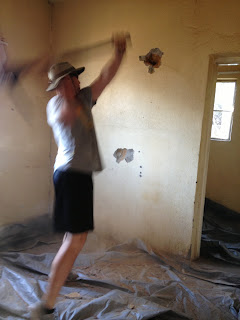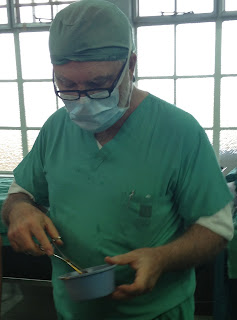Having been
The city of Lubango itself has been a surprise. I knew that it was a large city and all but
somehow the population density, noise, and lights are not jibing with whatever
paradigm I had for sub-Saharan Africa.
The amount of pollution – water, air, and ground – are more than I could
have imagined. The hilly streets are
ever-busy and I imagine a Lubango-themed Frogger proving…impactful. Having seen the
countryside this past weekend, I appreciate why Angolans would flock to urban
areas in search of employment and sustenance.
The end result of such congestion, however, is a Lubango that I did not
envision.
A highlight of the trip was meeting and living with the
Kubacki family. There are those persons
out there whom you meet and immediately say to yourself, “yes.” The five sixths of the family that I spent
time with have sincere passion for their calling and, in committing their lives
to others, have a beautiful sense of self.
I believe it to be true that I am, in some way, a better person for
having shared a roof those ten nights.
CEML both has and hasn’t been what
I had foreseen. It is, “the clinic on
the hill,” as the locals colloquially refer.
It is a tertiary referral center with an emphasis on surgery. It is a wonderful place to learn and develop
further my fundamentals. I was not expecting the surge of people
waiting for outpatient visits daily.
Sure, there is to be follow-up once discharged but to fill the hallways
for hours and hours per day? Another
thing about this hospital, which has pros and cons, is its revolving door
nature. The flux of domestic students, foreign
students, residents, doctors, missionary doctors, and affiliated folks is impressive. The pros are a wide array of exposure and
opinion. The cons are a lack of
institutional memory and the gaggle of white coats roaming through
the wards on rounds.
Another impression I need to touch on is the sense of community
shared by the missionaries and expatriates in Lubango. With Mitcha (the walled compound where Dr.
Foster and about five other families live) as a home base, these, mostly North
American, people function in an impressively cooperative group. Pizza Night Fridays are a nice adhesive but
the real good comes from a positively connoted groupthink. Random favors, organizing group trips, co-op
purchasing, and constant radio/phone communication all contribute to a collectively
higher quality of life.
Is
My Portuguese ability is not where I would like it to
be. I don’t know whether this is the
result of too high an ambition or too low an execution. Let’s say some of both so that I don’t feel
too bad about myself either way, OK? Thankfully,
I do have some faculty in the clinical setting but my, “conversations,”
otherwise are about eight seconds long.
I am sensing the value of the so-called immersion programs whereas I go
home through the week and away on the weekends speaking English every which
way. I am, though, certainly improved
and understand more everyday.
I am living a much more natural, simple life. Most of the food is not processed. Especially at Shangalala, I was up with the
sun around 6:00am and to bed after dark by 9:30pm. One must ensure access to clean drinking
water for the day. I have not seen live
television since arriving. I wear scrubs
and eat meals that are prepared. I am
immune from so much of the decision-related clutter of my regular life.
Today my rank order list is due. A sentimental milestone along the medial training path, it is now just twenty-three days until I open my envelope. Where is it that I will be completing residency?
This is really just whining but I am tired of bad smells. Trash, people +/- their infections, bat poop…
I am feeling a bit run down. The last couple days at CEML have been particularly trying. The weight of more deaths, one very unexpected, and a string of sad surgical cases are upon me. I debated whether or not to include the pictures below. In sharing, I am honoring my commitment to posting honestly and am also dealing with some blue feelings. I struggle a lot with the late stage at which so many of our patients present. Also chief among my thoughts is the lack of medicines and machines so commonplace in the States.
An 82 year old male. He presented with a much-progressed basal cell carcinoma. I thought of my anesthesia-bound roommate Ben when approaching intubating and preparing such a case. Unfortunately, his tumor had invaded both of his maxillary sinuses and his upper jaw. We resected much of the middle of his face. With no ventilator available outside of the OR, I am writing this wondering if he is still alive.
A 26 year old albino male. We see many albinos in Lubango. The expression of this recessive trait is the result of local inbreeding. Their skin, as you might imagine, is incredibly frail under the equatorial sun. He has an advanced squamous cell carcinoma. We were able to save his eye for the time being.
A 23 year old female. Hers is inflammatory breast cancer, now fungating, that has totally penetrated her chest wall. Twenty-three years old...
Will be
I am feeling a bit run down. The last couple days at CEML have been particularly trying. The weight of more deaths, one very unexpected, and a string of sad surgical cases are upon me. I debated whether or not to include the pictures below. In sharing, I am honoring my commitment to posting honestly and am also dealing with some blue feelings. I struggle a lot with the late stage at which so many of our patients present. Also chief among my thoughts is the lack of medicines and machines so commonplace in the States.
An 82 year old male. He presented with a much-progressed basal cell carcinoma. I thought of my anesthesia-bound roommate Ben when approaching intubating and preparing such a case. Unfortunately, his tumor had invaded both of his maxillary sinuses and his upper jaw. We resected much of the middle of his face. With no ventilator available outside of the OR, I am writing this wondering if he is still alive.
A 26 year old albino male. We see many albinos in Lubango. The expression of this recessive trait is the result of local inbreeding. Their skin, as you might imagine, is incredibly frail under the equatorial sun. He has an advanced squamous cell carcinoma. We were able to save his eye for the time being.
A 23 year old female. Hers is inflammatory breast cancer, now fungating, that has totally penetrated her chest wall. Twenty-three years old...
Will be
The rest of my time here will be very different from that already passed.
In the morning, I leave for Kalukembe. A one-hour flight in a nine-seat Cessna or a three-hour drive away, this is the bush hospital associated with CEML. We make monthly trips and operate pretty much non-stop for two and a half days. This hospital has some 200 beds and is staffed totally by nurses. The patients seen and cases performed are those complex enough to have been, "saved for the doctor." Pending my own experience, I will direct you to a video produced by the aviation ministry here in Angola.
I will return to Lubango Saturday afternoon. Only to re-pack and depart on Sunday for Chiulo. I am particularly excited by and fearful of this opportunity. As a budding medicine and pediatrics doc, the surgeries I have seen are very interesting but not so directly beneficial for my future practice. Chiulo is a hospital with 250 beds - children in 100 of them - that will be a less surgical experience than CEML. I am visiting for a week with Dr. Dan Cummings. He completed an Emergency Medicine residency some three years ago and is exploring sites for a two-year commitment in the future. His presence also is a stopgap for the chronic staffing issues at Chiulo. I had an opportunity to take a peek on the way back from Xangalala.
The front entrance to the hospital buildings:
In the morning, I leave for Kalukembe. A one-hour flight in a nine-seat Cessna or a three-hour drive away, this is the bush hospital associated with CEML. We make monthly trips and operate pretty much non-stop for two and a half days. This hospital has some 200 beds and is staffed totally by nurses. The patients seen and cases performed are those complex enough to have been, "saved for the doctor." Pending my own experience, I will direct you to a video produced by the aviation ministry here in Angola.
I will return to Lubango Saturday afternoon. Only to re-pack and depart on Sunday for Chiulo. I am particularly excited by and fearful of this opportunity. As a budding medicine and pediatrics doc, the surgeries I have seen are very interesting but not so directly beneficial for my future practice. Chiulo is a hospital with 250 beds - children in 100 of them - that will be a less surgical experience than CEML. I am visiting for a week with Dr. Dan Cummings. He completed an Emergency Medicine residency some three years ago and is exploring sites for a two-year commitment in the future. His presence also is a stopgap for the chronic staffing issues at Chiulo. I had an opportunity to take a peek on the way back from Xangalala.
The front entrance to the hospital buildings:
The hospital routinely has more patients than beds. Here is the extension of the women's ward onto the veranda:
Established in the late 1940's by the Medical Missionaries of Mary (an Irish order), Chiulo is now run by an Italian NGO. The original Catholic mission:
--
All in all, I am feeling as if I were a passenger in my own car:
the space is familiar and the controls the same but for whatever reason, it is
difficult adjusting to the parallax. I
mean that I am still Zach: I sleep heavily, I enjoy the night sky, I feel good
about myself when I remember to floss, etc.
It is just that I am passing the same twenty-four hours a day in such a
different way, in such a different place.
Here’s to some more Life Experience ahead…























































